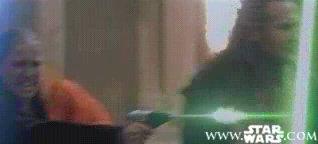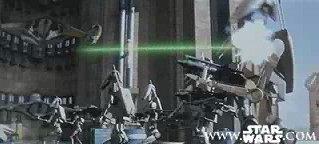

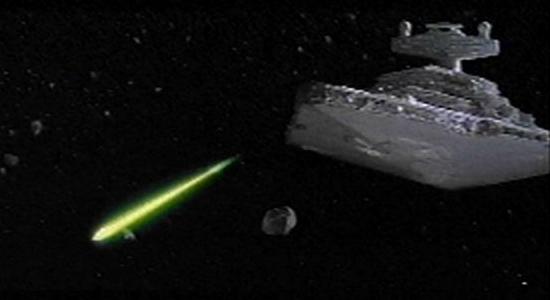
In the above picture, a TL bolt appears to take a specific geometric shape. The front of the bolt has the appearance of a cone. It quickly grows larger in diameter, until it reaches its maximum. The diameter of the bolt then gradually decreases along the length of the bolt, until it reaches a point close to the end of the bolt. At this point, the bolt has its minimum diameter. Then, the diameter of the bolt quickly increases again.
A possibility exists that the variations in diameter of the bolt may represent variations in the actual intensity of the bolt. The bolt itself may be only microscopic in diameter, and the several-meters-wide areas only glare. The reason for such variations in intensity is unclear. Perhaps these variations in some way assists the bolt in penetrating enemy shields?
Another possibility is that the bolt has varying frequencies throughout its length. This may explain the variations in observed "shape" of the bolt. It may also explain the "damage before contact" of some bolts (as seen in my TL nature page). The three different bolt sizes may actually be the result of varying frequencies. For example: a middle-sized bolt may be the same as a large sized bolt, but the beginning of the bolt is in the nonvisible spectrum. This part of the bolt may already be in contact with the target before the visible portion is.
The shape of the bolt is symmetrical. It can be rotated any number of degrees around its longitudinal axis, and its appearance to the viewer will remain unchanged.
Interestingly, the description of the TL bolt's shape also applies to that of a particular brand of modern shotgun sabot slug, which is typically used by hunters because of the superior aerodynamic qualities of the shape (called "Ballistic Coefficient" by firearm experts). This projectile is encased in a plastic sleeve which separates after exiting the barrel, and allows the bullet to continue to the target. This sabot slug effectively doubles the range of a modern shotgun.
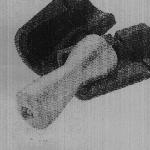
Blaster bolts have a similar shape, minus the enlargement on the end. The front of the bolt is shaped like a cone, then the observed diameter decreases along the entire length. This is true for vehicle blasters and hand blasters.
Another possibility is that turbolaser bolts have "pulses" similar to those in a superlaser bolt. These pulses could possibly explain the enlargements on the ends of the TL bolt.
Hand blaster bolts have similar "pulses", but a less-defined pattern. Pulses are seen in various points in the bolt, or sometimes not at all.

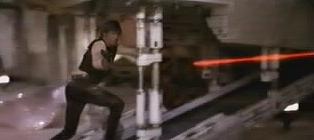
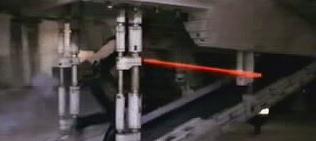
There are at least three different sizes of TL bolts witnessed in the films. The size of each of these bolts can be judged against the size of the Millenium Falcon. This is because at some time, each type of bolt has been fired at the Falcon.
It is probably safe to assume that the larger bolts result from more powerful cannons, or otherwise are the result of different power settings of the same weapons.
The following image represents one of the largest type:
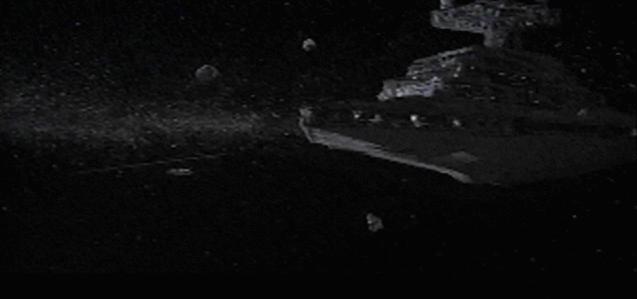
It is difficult to perform precise measurements of the length of the TL bolts because the size of the Falcon is unclear. Based on visual observation, the size of this vessel is between 25 and 40 meters long (see Robert Brown's Millennium Falcon page for more information). The TL bolt is roughly 5 times the length of the Falcon, so its length is approximately 125-200 meters.
The only time these bolts have been seen is the scene referenced above, the asteroid scene, and possibly when the Falcon "attacked" the ISD, as it was passing over the dorsal surface.
The medium size TL bolts appear to be the most common. These are seen in almost every scene in which ISDs are in combat. They are roughly 50 meters long, and are seen in the following image:
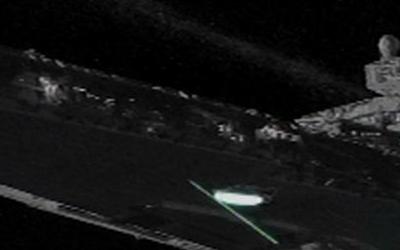
These bolts are usually seen fired at a rate of once every two seconds, but sometimes the rate increases to about once per second or more.
The smallest bolts are only a few meters long. They were witnessed in only two scenes: defeating the Falcon's shields in ESB, and firing on the Falcon as it was departing Tatooine.
They seem to have a rapid firing rate, possibly 2-3 times per second. Their use against the Falcon, and not against the Tantive IV, would indicate that these weapons are normally used against starfighters, freighters, and other small vessels. This makes sense because smaller rapid firing weapons would be more efficient against a nimble target, and would not be a large waste of power.
The small bolts are represented in the following image:

The ISD in pursuit of the Falcon in ANH fired short bolts at a high rate of fire.
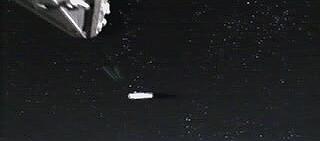
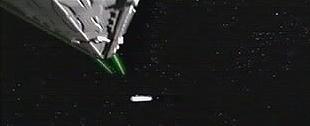
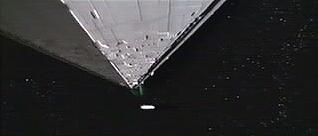
It is also interesting to note that an early concept drawing of an Imperator Class Star Destroyer by Geoffrey Mandel describes three different sizes of laser cannons. Also note that there are a total of 200 TL cannons mounted on the vessel.
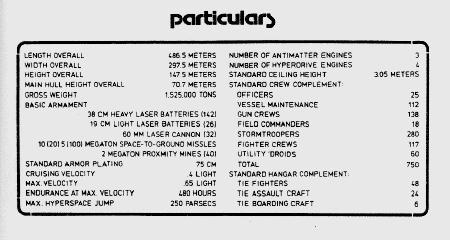
It is interesting to note that the size of the vessel changed, as well as the number of some types of weapons, which calls the validity of the blueprints into question.
It is also interesting to note that TLs only appear in two colors: red and green (lightsabres sometimes appear in white or blue however). Imperial weapons usually appear in green, and Rebel weapons in red. It is not known what the difference in these two bolts may be. They may be firing at different frequencies (if they are beam weapons), or (if they are formed from plasma) formed from different gases.
The Millennium Falcon is the only non-military ship seen firing in the films. The beams the Falcon fired were red, like the Rebels' beams. Perhaps the green bolts are more powerful or efficient, and are only available to the Empire (with its vast resources). Of course, the Falcon's weapons have probably been modified to military specs. Hand blaster bolts are always red in the classic trilogy. Only one example of green blaster fire has been seen.
